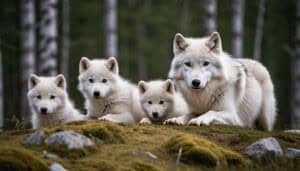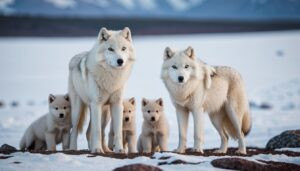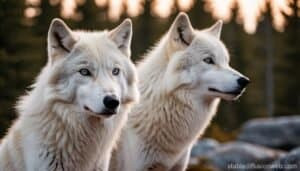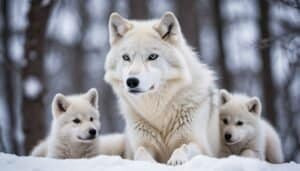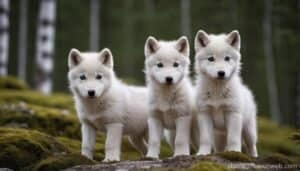Introduction
Arctic wolves display remarkable behaviors when it comes to caring for their young, ensuring the survival of their species in one of the harshest environments on Earth
This article delves into the typical behaviors of Arctic wolves towards their pups, the protection mechanisms they employ, the role of the pack in rearing young wolves, and the stages of growth and development
Additionally, it examines the impact of environmental conditions on parenting practices and the social structure within the pack during this critical period. Through this exploration, we gain a comprehensive understanding of how Arctic wolves nurture and raise their young in the wild
Typical Behaviors of Arctic Wolves Towards Their Young
Arctic wolves, also known as Canis lupus arctos, exhibit a range of nurturing behaviors that ensure the survival and well-being of their pups. These behaviors are crucial for the development of the young wolves, as they prepare them for the harsh conditions of the Arctic tundra
Parental Bonding and Affection
From the moment the pups are born, Arctic wolf parents, especially the mother, show a strong bond with their young. This bond is established through constant physical contact, grooming, and nuzzling
The mother wolf remains in close proximity to her pups, providing warmth and comfort in the cold environment. This close contact is essential for the pups’ survival, as it helps regulate their body temperature and fosters a sense of security
The father and other pack members also play a role in bonding with the pups. They bring food to the den and spend time interacting with the young wolves, reinforcing the familial bonds within the pack
These interactions are characterized by gentle play, grooming, and vocalizations, which help the pups recognize and trust their family members
Protective Instincts
Arctic wolf parents are highly protective of their pups. The den, typically located in a secluded area such as a cave or a dug-out burrow, serves as a safe haven for the young wolves. The mother wolf is vigilant and rarely leaves the den, ensuring that the pups are safe from potential threats
In addition to the physical protection provided by the den, Arctic wolves exhibit defensive behaviors to ward off predators. The parents are known to be aggressive when defending their territory, often working together to drive away intruders
This collective effort is crucial in protecting the vulnerable pups during their early stages of life
Protection From Predators
In the unforgiving Arctic environment, predators pose a significant threat to young wolf pups. Arctic wolves employ various strategies to safeguard their offspring from these dangers
Role of the Den
The den plays a pivotal role in the survival of Arctic wolf pups. It is carefully chosen for its location, which provides natural protection from predators and harsh weather conditions. The entrance is often narrow and concealed, making it difficult for larger predators to access
Inside, the den is spacious enough to accommodate the mother and her pups, providing a secure environment for them to grow
The mother wolf keeps the den clean and free of debris, ensuring a hygienic space for the pups. This cleanliness reduces the risk of infections and parasites, which can be detrimental to the young wolves’ health
Vigilance and Defense Mechanisms
Both parents are exceptionally vigilant, constantly on the lookout for potential threats. They rely on their keen senses of smell, hearing, and sight to detect danger from a distance. When a predator approaches, the parents alert the pack through vocalizations and body language
The pack’s response to a threat is coordinated and strategic. The adults form a protective perimeter around the den, using their bodies as a shield. They exhibit aggressive behaviors such as growling, snarling, and even physical attacks to deter the predator
This collective defense mechanism is highly effective in ensuring the safety of the pups
Role of the Pack in Raising Pups
Arctic wolves are social animals, and the entire pack is involved in the upbringing of the pups. This communal approach to rearing ensures that the young wolves receive ample care and protection
Communal Care and Feeding
The pack works together to provide food for the nursing mother and her pups. While the mother stays with the pups in the den, the rest of the pack hunts and brings back food. This cooperative hunting strategy ensures a steady supply of nourishment for the growing pups
Pack members take turns guarding the den and keeping watch for predators, allowing the mother to rest and recuperate. This shared responsibility lightens the mother’s burden and enhances the survival chances of the pups
Social Learning
From an early age, Arctic wolf pups observe and learn from the adults in the pack. They watch hunting techniques, social interactions, and communication methods. This observational learning is critical for their development, as it prepares them for independent life in the future
The adults also engage the pups in play, which serves as a form of education. Through play, the pups practice hunting skills, learn social hierarchies, and develop physical coordination. This playful interaction is a key aspect of their growth and development
Duration of Maternal Care
The length of time that Arctic wolf pups stay with their mother is crucial for their development and eventual independence. This period is marked by several key stages
Weaning Period
Arctic wolf pups are typically weaned at around six to eight weeks of age. During this time, they transition from their mother’s milk to solid food. The pack members assist in this process by regurgitating partially digested food for the pups, making it easier for them to consume and digest
Independence Milestones
As the pups grow, they begin to explore their surroundings under the watchful eyes of the adults. By the age of three to four months, they start joining the pack on short hunting excursions, learning the skills they will need to survive
Full independence is usually achieved by the time they are eight to ten months old, although they continue to rely on the pack for support and protection until they are fully mature
Early Nutrition and Teaching Hunting Skills
The early stages of an Arctic wolf pup’s life are critical for their development and survival. Nutrition plays a vital role during this period, and the parents, along with other pack members, are responsible for ensuring the pups receive adequate nourishment
Additionally, teaching the young wolves hunting skills is essential for their future independence
Nursing and Transition to Solid Food
In the initial weeks after birth, Arctic wolf pups rely entirely on their mother’s milk for nutrition. The mother’s milk is rich in antibodies and nutrients that are crucial for the pups’ growth and immune system development
During this nursing period, the mother remains close to the den, rarely venturing far to ensure she can feed her pups frequently
Around the age of six to eight weeks, the pups begin the weaning process. This transition from milk to solid food is gradual. The adult wolves, including the mother, regurgitate partially digested food for the pups
This regurgitated food is easier for the pups to consume and digest, providing a bridge between milk and the more challenging solid foods they will eat as they mature. This method also allows the pups to be introduced to the tastes and textures of their future diet
Observational Learning
Learning to hunt is a critical skill for Arctic wolf pups, and much of this learning occurs through observation. From a young age, pups watch the adults in the pack as they hunt and interact. This observational learning is crucial, as it allows the pups to understand hunting techniques, stalking methods, and the strategies involved in capturing prey
The pups also observe social interactions within the pack, learning about hierarchy and the roles of different pack members. This understanding of social structure is important for their integration into the pack as they grow older
Practice Hunts
As the pups grow stronger and more coordinated, they begin to participate in practice hunts. These practice sessions often involve smaller, less dangerous prey, allowing the young wolves to develop their hunting skills in a relatively safe environment
During these practice hunts, the pups learn how to work together, coordinate movements, and understand the nuances of hunting in a pack
The adult wolves play a crucial role during these practice hunts. They guide the pups, correct their mistakes, and demonstrate effective hunting techniques
This hands-on training is essential for the pups’ development, ensuring they acquire the necessary skills to survive and contribute to the pack’s success in future hunts
Survival Rates and Environmental Impact
The survival of Arctic wolf pups is influenced by various factors, including environmental conditions, predation, and the availability of food. Understanding these factors helps in comprehending the challenges faced by Arctic wolves in raising their young
Factors Influencing Survival
Several factors affect the survival rates of Arctic wolf pups. Predation by other carnivores, such as polar bears, can pose a significant threat. Harsh weather conditions and extreme temperatures in the Arctic tundra also impact the pups’ survival
Additionally, the availability of prey plays a critical role; a scarcity of food can lead to malnutrition and increased mortality rates among the young wolves
Statistics and Trends
Survival rates of Arctic wolf pups can vary widely depending on the year and the specific conditions they face. In general, survival rates are higher when prey is abundant and weather conditions are favorable
However, in years with scarce prey and harsh winters, the mortality rate of pups can be significantly higher. Studies have shown that in some years, up to 60% of Arctic wolf pups may not survive to adulthood
Climate Challenges
Climate change poses new challenges for Arctic wolves. Rising temperatures and changing weather patterns can disrupt the availability of prey and alter the landscape, making it more difficult for wolves to find food and suitable den sites
Melting ice and permafrost can also impact the stability of dens, increasing the vulnerability of pups to predation and harsh weather
Adaptations to Extreme Conditions
Arctic wolves have developed several adaptations to survive in extreme conditions. Their thick fur provides insulation against the cold, while their large paws help them navigate through snow
These physical adaptations, combined with their social behaviors and cooperative hunting strategies, enhance their ability to thrive in the harsh Arctic environment
Social Structure During Pup-Rearing
The social structure of an Arctic wolf pack plays a vital role in the successful rearing of pups. Understanding the pack’s hierarchy and the responsibilities of different members provides insight into how Arctic wolves care for their young
Pack Hierarchy and Responsibilities
An Arctic wolf pack typically consists of an alpha pair (the dominant male and female), their offspring, and sometimes other related or unrelated wolves. The alpha pair is primarily responsible for breeding and leading the pack
During the pup-rearing period, the alpha female (mother) is the primary caregiver, while the alpha male (father) provides protection and food
Other pack members, known as subordinates, also play crucial roles. They assist in hunting, guarding the den, and caring for the pups. This communal care system ensures that the pups receive adequate attention and resources, increasing their chances of survival
Interactions Among Pack Members
Interactions within the pack are essential for maintaining harmony and cooperation. Social behaviors such as grooming, playing, and vocalizations help strengthen bonds between pack members
These interactions also provide the pups with opportunities to learn about social dynamics and their place within the pack hierarchy
Growth and Development of Pups
The growth and development of Arctic wolf pups are critical for their eventual survival and integration into the pack
This process encompasses various stages of physical growth, behavioral changes, and social development, all of which are essential for preparing the pups for adulthood
Physical Development Stages
Arctic wolf pups undergo rapid physical growth in their first few months of life. At birth, they are small, blind, and heavily reliant on their mother. Their eyes typically open at around 10 to 15 days, and they begin to hear and respond to sounds shortly thereafter
This period marks the beginning of their sensory development, which is crucial for their survival
By the time they are four weeks old, the pups start to explore their immediate surroundings outside the den. They gain strength in their legs and begin to play with their littermates, which helps develop their motor skills and coordination
This playful behavior is not only essential for physical development but also for learning social interactions
As they reach two to three months of age, the pups grow rapidly and begin to resemble miniature versions of adult wolves. Their teeth come in, enabling them to chew solid food, and their fur thickens to provide better insulation against the cold
By six months, they are nearly as large as adult wolves, although they continue to fill out and develop muscle mass over the next year
Behavioral Changes
Behavioral development is equally important for Arctic wolf pups. Initially, their behavior is centered around the den, where they spend most of their time nursing and sleeping
As they grow older, their curiosity leads them to explore their environment more extensively. This exploration is critical for developing their senses and understanding their habitat
Play behavior is a significant aspect of their development. Through play, pups practice hunting techniques, such as stalking, pouncing, and wrestling with their siblings. These activities are crucial for honing their skills and preparing them for real hunting scenarios
Play also helps establish social hierarchies within the litter, teaching the pups about dominance and submission
Interaction with adult pack members further shapes their behavior. The pups learn from observing the adults’ actions, particularly during hunts. This learning process is vital for acquiring the knowledge and skills necessary for survival
Additionally, the pups start to understand the social structure of the pack and their role within it
Conclusion
Arctic wolves exhibit remarkable and complex behaviors when it comes to caring for their young, ensuring the survival of their species in one of the harshest environments on Earth
From the strong parental bonds and protective instincts to the communal efforts of the pack, every aspect of their life is geared towards nurturing and safeguarding the pups. The den provides a safe haven, while the vigilant defense mechanisms and strategic pack roles ensure protection from predators
The development of Arctic wolf pups involves a delicate balance of nutrition, learning, and social interaction. The transition from nursing to solid food, combined with observational learning and practice hunts, equips the pups with the necessary skills for survival
The growth and behavioral changes during their early months prepare them for eventual independence and integration into the pack’s social structure
Environmental factors and climate challenges further influence the survival rates and parenting strategies of Arctic wolves. Despite these challenges, their adaptive behaviors and communal efforts highlight the resilience and cooperative nature of these magnificent animals
Through understanding these intricate dynamics, we gain a deeper appreciation for the Arctic wolves’ role in the delicate balance of the Arctic ecosystem


